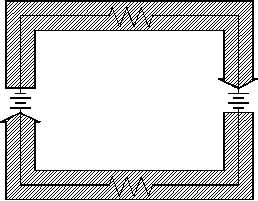Basic DC Theory
KIRCHHOFF’S LAWS
The mathematics involved becomes more difficult as the circuits become more complex.
Therefore, the discussion here will be limited to solving only relatively simple circuits.
Kirchhoff’s Voltage Law
Kirchhoff’s first law is also known as his "voltage law." The voltage law gives the relationship
between the "voltage drops" around any closed loop in a circuit, and the voltage sources in that
loop. The total of these two quantities is always equal. In equation form:
Esource = E1 + E2 + E3 + etc. = I1R1 + I2R2 + I3R3 + etc.
SEsource = SIR
(2-14)
where the symbol S (the Greek letter sigma) means "the sum of."
Kirchhoff’s voltage law can be applied only to closed loops (Figure 32). A closed loop must
meet two conditions:
1.
It must have one or more voltage sources.
2.
It must have a complete path for current flow from any point, around the loop,
and back to that point.
You will remember that in a simple series circuit, the sum of the voltage drops around the circuit
Figure 32 Closed Loop
is equal to the applied voltage. Actually, this is Kirchhoff’s voltage law applied to the simplest
case, that is, where there is only one loop and one voltage source.
Rev. 0
Page 43
ES-02




